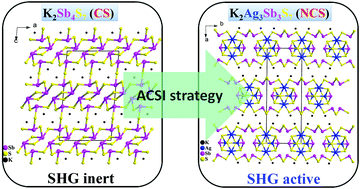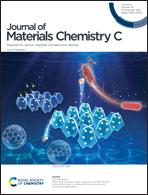Aliovalent-cation-substitution-induced structure transformation: a new path toward high-performance IR nonlinear optical materials†
Abstract
Non-centrosymmetric (NCS) structure is the precondition and foundation for the development of high-performance nonlinear optical (NLO) crystals. In this research, a quaternary NCS thioantimonate, K2Ag3Sb3S7, is designed through an aliovalent-cation-substitution-induced strategy based on the centrosymmetric (CS) parent compound K2Sb4S7 and successfully obtained through a facile surfactant-thermal technology. The unique crystal structure of K2Ag3Sb3S7 belongs to the orthorhombic space group Cmc21 (no. 36) and is made of charge-balanced K+ cations and two-dimensional (2D) anionic layers [Ag3Sb3S7]2− constructed by the vertex-sharing of ∞[Ag3SbS5]4− and ∞[SbS2]− chains. Remarkably, K2Ag3Sb3S7 not only possesses a phase-matching (PM) ability in the IR region, but also displays a perfect balance between a high second-harmonic-generation (SHG) coefficient (1.5 × commercial AgGaS2) and a large laser-induced damage threshold (3.2 × commercial AgGaS2). Moreover, theoretical studies uncover that the synergistic effects of three types of asymmetric building motifs (i.e., [SbS3], [Sb2S5] and [Ag3S6]) contribute to the large SHG effect and birefringence (Δn). This study not only demonstrates that aliovalent cation substitution can be a robust means of obtaining the NCS thioantimonates but also provides a deeper insight into the structure–property relationship of IR-NLO chalcogenides.

- This article is part of the themed collections: Journal of Materials Chemistry C Lunar New Year collection 2022 and 2021 Journal of Materials Chemistry C most popular articles


 Please wait while we load your content...
Please wait while we load your content...